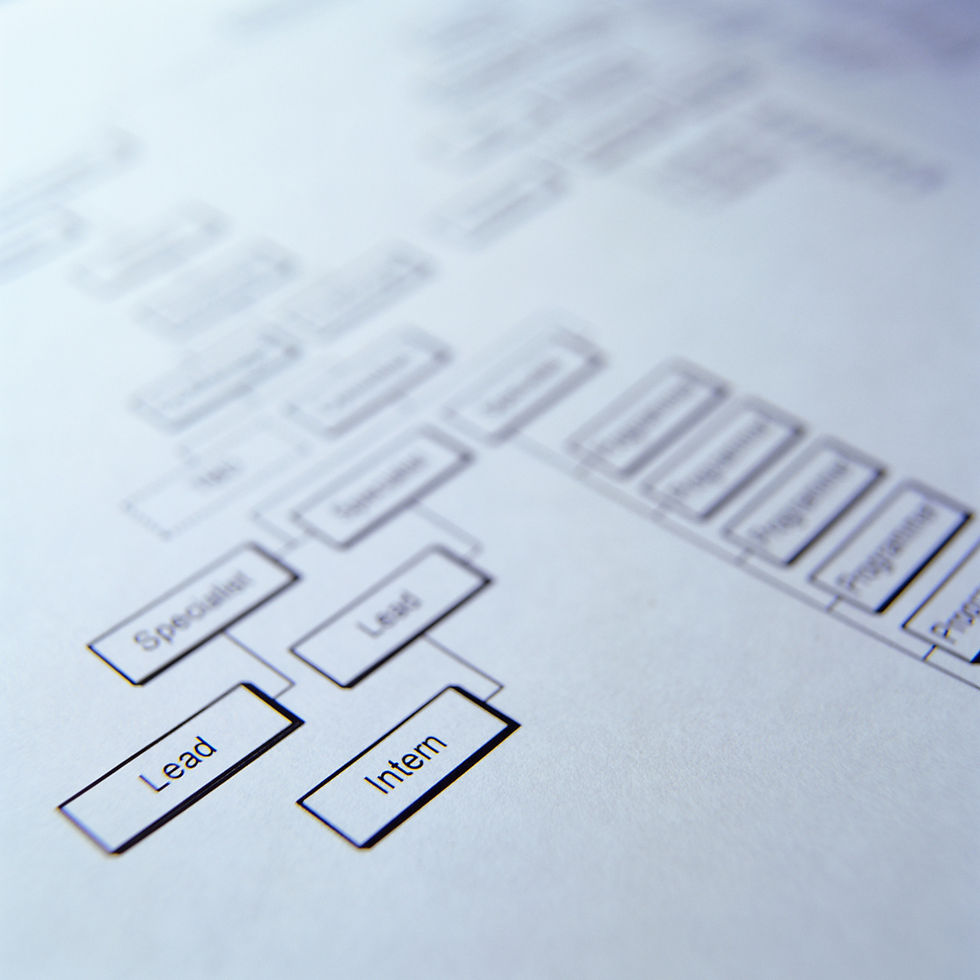The Complete Guide to Organisational Charts: Uses and Benefits
- SPS International

- Oct 9, 2023
- 5 min read
Organisational charts, commonly referred to as org charts or org structures, are essential tools for visualising the hierarchical structure of a company.
They serve as a roadmap for understanding the relationships between different roles and positions within an organisation. As such, when it comes to identifying skill gaps, lack of staff resources or guiding a reorganisation, they can be absolutely vital.
In this comprehensive guide, we will explore what organisational charts are, the various types of org charts, their pros and cons, how they help plan a company's future, and practical tips on creating your own.

What Are Organisational Charts?
Organisational charts, or org charts, are visual representations of an organisation's structure in terms of staffing.
They provide a visual overview of how the company is organised, including the reporting relationships between various positions and departments.
Org charts typically use a hierarchy of boxes or shapes to represent different roles and connect them with lines to illustrate who reports to whom. This can form a type of tree which allows anyone to clearly understand the distribution of staffing and the way teams are formed and run.
Types of Organisational Charts
There are several types of organisational charts, each with its own unique format and purpose. The choice of which type to use depends on the specific needs and goals of the organisation.
Depending on what you’re looking to understand through your organisational chart, your may take different formats. Here are some common types of org charts, to help you identify what would best suit your needs:
1. Hierarchical Organisational Chart
- Description : This is the most traditional and widely used type of org chart. It displays a clear top-down structure, with the CEO or president at the top and various levels of management, teams and employees beneath.
- Use : Ideal for organisations with a well-defined chain of command.
2. Matrix Organisational Chart
- Description : Matrix org charts showcase both vertical and horizontal reporting relationships. Employees have dual reporting responsibilities to both line managers and project managers, showcasing clearly who is working on certain projects and the level of responsibility for each person.
- Use : Suited for organisations with complex project-based work where it needs to be clear which project or client staff are working on.
3. Functional Organisational Chart
- Description : In this type, employees are grouped based on their functions or areas of expertise, such as their departments, teams and sub teams. It emphasises specialisation and departmental divisions.
- Use : Common in large organisations with distinct departments. It can also be used to identify skill gaps in teams.
4. Divisional Organisational Chart
- Description : Divisional org charts divide the organisation into self-contained divisions or units, each with its own management structure. This is often used by companies with multiple product lines or geographical locations.
- Use : Effective for decentralised organisations with a wide global reach.
5. Flat Organisational Chart
- Description : A flat org chart minimises the number of hierarchical levels, resulting in a more decentralised structure. It encourages collaboration and can be found in startups or small businesses.
- Use : Suitable for organisations that value a team-oriented approach, and who want to promote a more collaborative way of working.
Pros and Cons
Organisational charts offer several advantages, but they also have limitations. Here's a look at the pros and cons of using org charts:
Pros:
1. Clarity and Visualisation:
Org charts provide a clear visual representation of an organisation's structure, making it easier for employees to understand their roles and reporting relationships within the business.
2. Communication:
They facilitate effective communication for staff of all levels by clearly showing who to contact for specific matters or decisions at different levels of the organisation.
3. Decision-Making:
Org charts aid in decision-making by identifying key decision-makers and their areas of responsibility for all to see.
4. Succession Planning:
They help in identifying potential successors for critical roles, aiding in succession planning and impacting the future of an organisation.
5. Resource Allocation:
Organisational charts also assist in allocating resources efficiently by showing where teams or departments fit within the organisation. This can also help to identify areas where work is bottleneck, or where additional team resources are needed to become more efficient.
Cons:
1. Simplicity:
Some org charts may oversimplify complex reporting relationships or lateral collaboration, which can lead to misunderstandings.
2. Rigidity:
Traditional org charts can be rigid and may not reflect the dynamic nature of modern organisations. To start with, you may find that roles and responsibilities are mixed, so it might be hard to create a clear and defined picture of the organisation.
3. Resistance:
If the above are the case when you start creating your organisational chart, employees may resist being boxed into specific roles or positions defined by the chart.
Planning the Future of Your Company
Organisational charts play a pivotal role in planning for the future of your company. Here's how they contribute to strategic planning:
1. Identifying Talent Gaps:
Org charts help identify areas where talent gaps exist. This insight can help to inform recruitment and training strategies, ensuring your business has the skill and talent needed to continue on a growth trajectory.
2. Succession Planning:
By visualising the hierarchy, you can identify potential successors for key positions, ensuring a smooth transition in case of leadership changes.
3. Scalability:
Org charts show how departments and teams are structured, aiding in the assessment of your organisation's ability to scale up as the business grows, and identify the need for further staffing if necessary.
4. Restructuring:
When considering organisational restructuring, organisational charts serve as a starting point for evaluating new structures and reporting relationships and how these may potentially change during a restructure.
5. Resource Allocation:
A chart can also assist in allocating resources strategically, ensuring that the right teams and departments receive the necessary support. It can also highlight areas where individuals or teams are overworked, and might need a change to ensure a more efficient working process.
How to Create Your Own Organisational Chart
As we’ve highlighted, there are a range of benefits associated with having an up-to-date organisational chart, which can offer strategic growth advantages in the future.
Creating an organisational chart can be done through various means, ranging from traditional paper and pen through to specialised software. Here's a step-by-step guide to creating your organisational chart:
1. Gather Information:
Begin by collecting information about your organisation's current structure, including job titles, names of employees, and their reporting relationships.
2. Choose a Format:
From this information and the type of work you do as an organisation, determine the type of org chart that best suits your organisation's needs (e.g., hierarchical, matrix, or functional).
3. Select Tools:
Choose the tools or software you'll use to create the org chart. Options include dedicated org chart software, straightforward presentation software (like PowerPoint or Google Slides), or even pen and paper, depending on what works best for you.
4. Organise Hierarchy:
Start with the top-level position (e.g., CEO) and work your way down, adding boxes or shapes for each role. Connect them with lines to show reporting relationships.
5. Include Information:
Add the names of employees to each position, along with any relevant details, such as job titles or department names. If presenting this information, you can also provide information on the department or team and an overview of what they deliver.
6. Review and Revise:
Review the org chart for accuracy and completeness. Make revisions as needed to reflect the current organisational structure based on the feedback of relevant stakeholders, such as team leaders or executives of different areas.
7. Share and Update:
Distribute the org chart to relevant parties within the organisation and update it regularly to keep it current, so you can continue to enjoy the benefits we highlighted above.
In conclusion, organisational charts are invaluable tools for businesses of all sizes and industries.
They provide clarity, enhance communication, aid in strategic planning, and assist in talent management. By understanding the different types of org charts and their benefits, you can make informed decisions about how to structure and visualise your organisation's hierarchy.
Whether you're starting from scratch or updating an existing org chart, following best practices, like those we highlighted above, will ensure that your org chart serves as an effective tool for your organisation's success.





